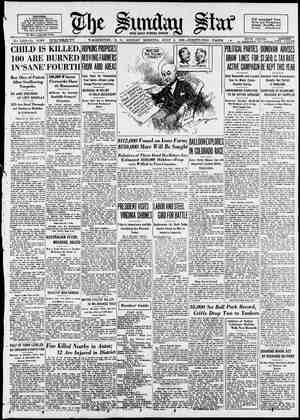Evening Star Newspaper, July 5, 1936, Page 76
You have reached the hourly page view limit. Unlock higher limit to our entire archive!
Subscribers enjoy higher page view limit, downloads, and exclusive features.
o THE SUNDAY STAR, WASHINGTON, D. C.—GRAVURE SECTION—JULY 5, 1936. Independence Day July 4, 1776—the day re- bellion became revolution and the victorious fight for independence began. Prepared from “The Pageant of America” Copyright by Yale University Press. NEW YORK CELEBRATES THE NEWS. It was July 10 before news of the adoption of the Declaration of Independence had reached the ears of enough New Yorkers to cause this demonstration. They are pulling down the King’s statue to melt it into bullets. The head of the statue was preserved by Tories but the lead body was taken to Litchfleld, Conn., and there made into ammunition to be used against the King's troops. Engraving by John C. Rae of the painting by Johannes A. Oertel Left: ORATOR OF THE REVOLUTION. Patrick Henry, who thundered in the Virginia Convention at Richmond, in 1775, those imper- & ishable words, “Give A E - - me liberty, or give e el : .4 me death!” The THE FIRST DECLARATION. A hundred years before, in orator of the Revo- 1676, Nathaniel Bacon signed a famous “Declaration of the . lntlon‘ had been People of Virginia” wherein the King's Governor was vigor- : found! oucly arrgigned. Bacon led a rebellion against royal misrule : From a miniature on but it collapsed when he died suddenly. He is pictured above ivory painted by Law- at the burning of Jamestown in the painting by Howard Pyle. i $ rence Sully in 1795 © Harper & Bros. | - BOSTON HEARS THE DECLARATION. Colonists of yesterday hear the Declaration of Inde- pengence read from the Old State House at Boston. And on July 18, “The King's arms and every sign with any resemblance of it . . . together with every sign that belonged to a Tory, was tzken down and the latter made a general conflagration of in King street.” © Halliday Historic Photograph Co. 7 THE FIRST PRAYER IN CONGRESS. In WakMm Prace -— Hewr _ September, 1774, the first Continental Congress - met and offered up a petition for Divine guid- ance through days which were ominously tur- bulent. The four kneeling figures in the left foreground are, left to right, Patrick Henry, John Rutledge of South Carolina, George Washington and Peyton Randolph of Virginia. Standing be- hind them to the left are Samuel and John Adams of Massachusetts. An engraving by Sadd after a painting by T. H. Matteson. EeEea———aaa) Right: WASHINGTON HEARS IT. Declaration of Independence is read to Gen. Washington and his officers on July 9, 1776. To him it meant that Congress, engrossed for a year of the war with the political decision, now could turn its attention to organizing an effective army. From the painting by Percy Moran. PAUL REVERE — EN- GRAVER. This rude car- toon by the famous “watch- man” of the Revolution depicts an unpleasant hell yawning for those who were too timid or merce- nary to stand against Brit- ish importations in the 5 pre-Revolutionary days. Right: RAISING THE LIBERTY POLE. Omens of revolution, liberty poles were raised in cities and towns all along the sea- g " \ : . - 75 board as King George III e . B3 T g{:fi,bg‘:,y m'{‘gs'e,':a,,fgg‘ig g Ly ) THE SPIRIT OF INDEPENDENCE. James Otis, brilliant lawyer, philosopher and literary man, re- their power over the colo- 2 % 3 4 signed as advocate general of Massachusetts to prote st the writs of assistance on behalf of the merchants Ll . ” A -~ A vy of New England. His flery words before the court in 1761 laid the foundation for arguments soon to be An engraving by McRare after 5 ~ heard throughout the colonies in their struggle for freedom. the painting by Chapman. e T S » . From the mural painting by Robert Reid in the State House, Bostor
